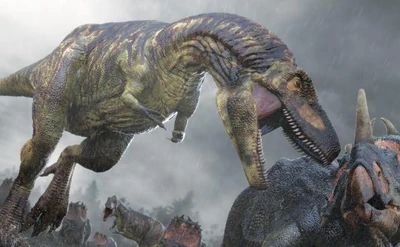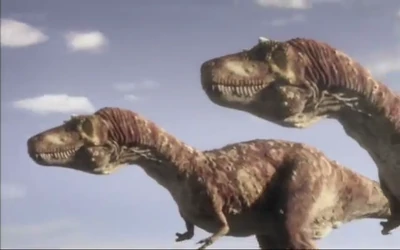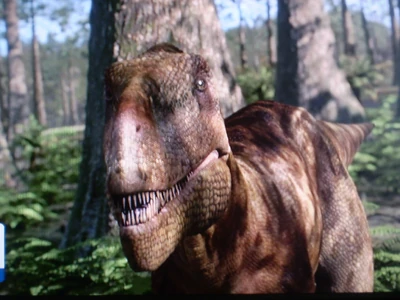| Tyrannosaurs | |
|---|---|
| File:Placeholder person.png | |
| Vital statistics | |
| Title | Tyrannosauroidea |
| Gender | Male/ Female |
| Race | Tyrannosauridos |
| Faction | {{{faction}}} |
| Health | {{{health}}} |
| Level | {{{level}}} |
| Status | {{{status}}} |
| Location | North America |

Daspletosaurus - a Canadian Tyrannosaur
Tyrannosaurs or tyrannosauroids are a large group theropod dinosaurs in the Late Cretaceous Period. They first evolved around 150 million years ago during the Late Jurassic period in China. The first tyrannosaur was Guanlong, a crested small sized theropod that was a swift hunter. As the Cretaceous period begins,and environments rapidly change, tyrannosaurs evolved a larger skull, teeth and body with their arms shortening over time. When the land bridge Berengia had connected the 2 separate continents of Asia and the Americas during the Early Cretaceous Period, some tyrannosaurids crossed the land bridge in pursuit of their migrating prey across Beringia toward North America, while some stayed in their original habitat. By the Late Cretaceous Period, around 75 million years ago, tyrannosaurs dominated the North Hemisphere. Large sized tyrannosaurs during this period are characterized by their huge narrow skulls filled with teeth from medium blde-like to large banana sized teeth. Their massive heads were hung by a strong neck with a robust, but lightly boned body balanced by a massive tail. Another unique feature is that their arms were very short and powerful with only 2 digits remaining. Some paleontologists believed that their arms were probably used by males to "scratch" the female's back to seduce her into mating. Though there is no proof of sexual dimorphs, scientists suspect that female tyrannosaurs were larger than males. Plus, the growth stage of a Tyrannosaur is also unique: When hatched from its egg, baby tyrannosaurs have a long skull, small teeth and a very agile and light body and may have eaten small animals. As they grow into their adolescents than toward adulthood (around 12 years of age to maximum 30), their bodies grow larger, skulls and arms shorten and their bones more heavier and have preyed on other orthinopod and sauropod dinosaurs. Tyrannosaurs also had surprisingly large brains for their body size! According to anaylsis, although a large portion of its brain is concentrated on smell, its large neocortex suggested that they were capable of communicating with each other and thus for strategies to hunt down prey. In these family tyrannosaur "gangs", the light young and adolescent provide the speed and agility to pursue and surround prey, while the larger and more massive adults provide the power to bring down prey. Numerous bite marks and puncture wounds on tyrannosaur skulls are common, suggesting that confrontation for the best parts between the adults and the adolescents were far from harmonious or democratic. The adults simply take all! Tyrannosaurids were the apex predators of the continents of Gondwana in the Northern Hemisphere, which comprises of North America and Asia. Only Europe was ruled by Abelisaurids.They shared the many arid and freezing environments with Ceratopsians, Hadrosaurs, Pachycephalosaurs, Therozinosaurs, Ornithomimids, Troodontids and Maniraptorids. They have appeared in the episodes "Last Killers" with Daspletosaurus and "The Great Survivors" with Alectrosaurus and Zunityrannus.

Alectrosaurus - an Asian Tyrannosaur

Zunityrannus - a Mexican Tyrannosaur